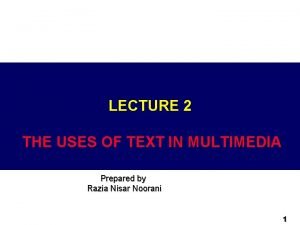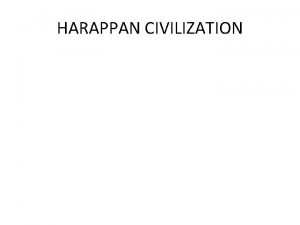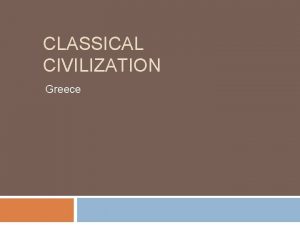What is a civilization Popular usage defines civilization












- Slides: 12

What is a civilization?

� Popular usage defines "civilization" along these lines: "an advanced state of human society, in which a high level of culture, science, industry and government have been reached. " This definition is problematic for archeologists, anthropologists, and historians, because it contains an overt value judgment that civilization is better, more advanced, and superior to other forms of social organization.

The most influential theorist of civilization in the Western world during the first half of the twentieth century was a professor of prehistoric archeology, V. Gordon Childe (1892 -1957), who taught at Edinburgh University from 1927 -46 and at London University 1946 -56. Childe's checklist for what constitutes a civilization still influences our thinking; here is his list summarized briefly: � Large urban centers � Full-time specialist occupations � Primary producers of food paying surpluses to deity or ruler � Monumental architecture � Ruling class exempt from manual labor � System for recording information � Development of exact, practical sciences � Monumental art � Regular importation of raw materials � Interdependence of classes (peasants, craftspeople, rulers) � State religion/ideology � Persistent state structures �

� Bands: small groups of 25 -60 individuals who are related through family and marriage ties, typically mobile hunters/gatherers. � Tribes: settled farmers or pastoralist herders, from a few hundred to a few thousands individuals whose identity is based on a concept of descent from a common ancestor; they are loosely organized without central control or strongly developed social hierarchy. � Chiefdoms: may number over 10, 000 individuals, in which institutionalized differences in rank and status are embedded in a hierarchy of lineages ruled over by a chief; a key feature is redistribution, in which subordinate sectors pay tribute to the chief who redistributes it to his followers.

� Agrarian civilizations: large (over 60100, 000), complex societies ruled by kings, with social stratification and coerced tribute, cities fed by surrounding farmers � Industrial nations: highly complex societies with large-scale governmental presence in lives of citizens � Modern global society: world-wide human society interconnected by rapid communications (airlines, Internet, e-mail)

� Mesopotamia and Egypt: 3100 BC � In about 3200 BC the two earliest civilizations develop in the region where southwest Asia joins northeast Africa. Great rivers are a crucial part of the story. The Sumerians settle in what is now southern Iraq, between the mouths of the Euphrates and the Tigris. Egypt develops in the long narrow strip of the Nile valley. � Rivers offer two main advantages to a developing civilization. They provide water to irrigate the fields, and they offer the easiest method of transport for a society without paved roads. Rivers will play an equally important role in two other early civilizations - those of the Indus and of northern China.

� The Indus: 2500 BC � It is not known whether contact with Mesopotamia inspires the first civilization of India or whether it is a spontaneous local development, but by about 2500 BC the neolithic villages along the banks of the Indus are on the verge of combining into a unified and sophisticated culture. � The Indus civilization, with its two large cities of Harappa and Mohenjo-daro, expands over a larger region than Egypt and Mesopotamia combined. It will survive, in a remarkably consistent form, for about 1000 years.

� China: � 1600 BC The longest consistent civilization in the human story so far is that of China. This vast eastern empire seems set apart from the rest of the world, fiercely proud of its own traditions, resisting foreign influences. Its history begins in a characteristically independent manner. � There are no identifiable precedents for the civilization of the Shang dynasty, which emerges in China in about 1600 BC. Its superb bronze vessels seem to achieve an instant technological perfection. Its written texts introduce characters recognizably related to Chinese writing today. This is a civilization which begins as it will continue - with confidence. �

� America: 1200 BC � Around this time the earliest American civilizations have their beginnings, with the Olmecs in central America and the Chavin in the Andes. � Both these cultures develop large towns, centred on temples. Both are now famous for their sculpture. And each, in its own region, is at the start of a succession of civilizations leading directly to the two which are discovered and destroyed in the 16 th century by the Spanish the Aztecs in central America and the Incas in the Andes.

� The Mediterranean: from 1000 BC � The first distinctively Mediterranean civilization, that of the Aegeans, comes to a sudden and still unexplained end in around 1200 BC. Some 200 years later an energetic seafaring people, the Phoenicians, become extensive traders. From their base in Lebanon they establish colonies along the coast of Africa and even into the Atlantic. � Their example, as Mediterranean imperialists, will be followed by the Greeks and then by the Romans. The Mediterranean becomes the world's most creative arena for the clash and synthesis of civilizations - a status which it has never entirely lost

� Regional civilizations: AD 400 - 1500 � With the dominance of Greece and Rome in the west (both successfully managing a transition from pagan to Christian empires), of China in the east, and of strongly individual cultures in central and south America, each successive civilization in any region tends at this time to be a variation on local traditions. But sometimes there are upheavals which introduce an entirely new culture within already long-civilized parts of the world. � One such is Islam. The establishment of the caliphate in Damascus and then Baghdad leads to distinctively Muslim civilizations in an unbroken belt from north Africa to north India.

� Global civilization: 16 th - 20 th century � The first sustained contact between Europe and America, in the 16 th century, opens the door to a new concept - world-wide civilizations, evolving through colonies and empires. Spanish civilization is exported to Latin America. English culture spreads even further, in an empire which includes India, Australia, New Zealand, Canada and eventually many parts of Africa. � From the 16 th to the 19 th century it is this imperial impulse which carries European civilization round the world, often as a thin veneer over older and very robust local cultures. But by the 20 th century there are different forces at work.
 Tshark usage
Tshark usage Fonction d'usage d'un pont
Fonction d'usage d'un pont Correct apostrophe usage
Correct apostrophe usage Adjective comparative superlative fantastic
Adjective comparative superlative fantastic Examples of text in multimedia
Examples of text in multimedia Activity resource usage model and tactical decision making
Activity resource usage model and tactical decision making Malis sur emballage
Malis sur emballage Qlikview usage cal
Qlikview usage cal Characteristics of mainframe computer
Characteristics of mainframe computer Windchill bulk migrator
Windchill bulk migrator Future perfect continuous tense usage
Future perfect continuous tense usage Comp1 and comp2 in cobol
Comp1 and comp2 in cobol Internal usage only
Internal usage only























